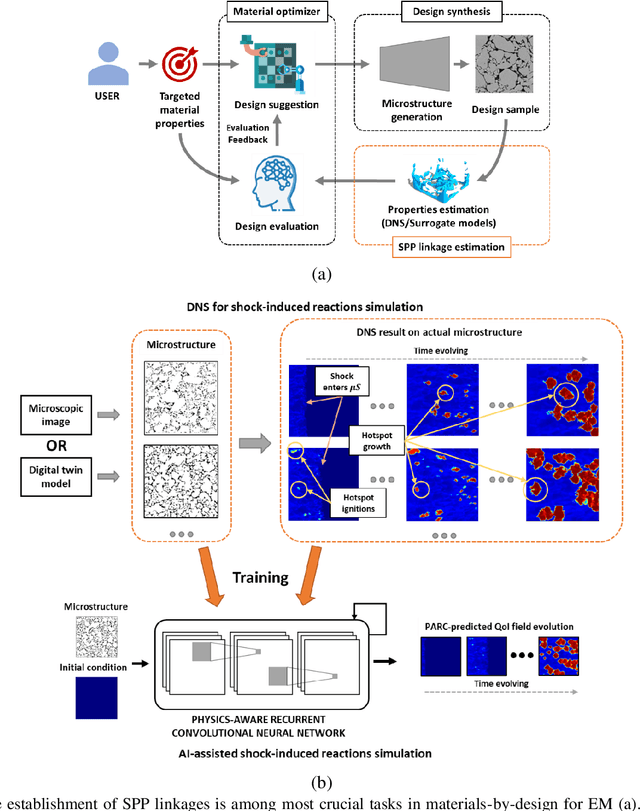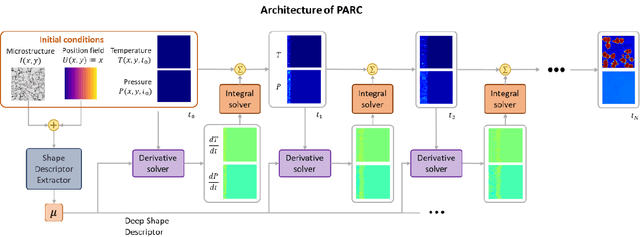Yen-Thi Nguyen
A physics-aware deep learning model for energy localization in multiscale shock-to-detonation simulations of heterogeneous energetic materials
Nov 08, 2022



Abstract:Predictive simulations of the shock-to-detonation transition (SDT) in heterogeneous energetic materials (EM) are vital to the design and control of their energy release and sensitivity. Due to the complexity of the thermo-mechanics of EM during the SDT, both macro-scale response and sub-grid mesoscale energy localization must be captured accurately. This work proposes an efficient and accurate multiscale framework for SDT simulations of EM. We employ deep learning to model the mesoscale energy localization of shock-initiated EM microstructures upon which prediction results are used to supply reaction progress rate information to the macroscale SDT simulation. The proposed multiscale modeling framework is divided into two stages. First, a physics-aware recurrent convolutional neural network (PARC) is used to model the mesoscale energy localization of shock-initiated heterogeneous EM microstructures. PARC is trained using direct numerical simulations (DNS) of hotspot ignition and growth within microstructures of pressed HMX material subjected to different input shock strengths. After training, PARC is employed to supply hotspot ignition and growth rates for macroscale SDT simulations. We show that PARC can play the role of a surrogate model in a multiscale simulation framework, while drastically reducing the computation cost and providing improved representations of the sub-grid physics. The proposed multiscale modeling approach will provide a new tool for material scientists in designing high-performance and safer energetic materials.
Physics-Aware Recurrent Convolutional (PARC) Neural Networks to Assimilate Meso-scale Reactive Mechanics of Energetic Materials
Apr 04, 2022



Abstract:The thermomechanical properties of energetic materials (EM) are known to be a function of their microscopic structures, i.e., morphological configurations of crystals and pores. This microstructural dependency has motivated vigorous research in the EM community, seeking to engineer material microstructures with targeted properties and performance under the materials-by-design paradigm. However, establishing the complex structure-property-performance (SPP) relationships of EMs demands extensive experimental and simulation efforts, and assimilating and encapsulating these relationships in usable models is a challenge. Here, we present a novel deep learning method, Physics-Aware Recurrent Convolutional (PARC) Neural Network, that can "learn" the mesoscale thermo-mechanics of EM microstructures during the shock-to-detonation transition (SDT). We show that this new approach can produce accurate high-fidelity predictions of time-evolving temperature and pressure fields of the same quality as the state-of-the-art direct numerical simulations (DNS), despite the dramatic reduction of computing time, from hours and days on a high-performance computing cluster (HPC) to a little more than a second on a commodity laptop. We also demonstrate that PARC can provide physical insights, i.e., the artificial neurons can illuminate the underlying physics by identifying which microstructural features led to critical hotspots and what are the characteristics of "critical" versus "non-critical" microstructures. This new knowledge generated alongside the capacity to conduct high-throughput experiments will broaden our theoretical understanding of the initiation mechanisms of EM detonation, as a step towards engineering EMs with specific properties.
 Add to Chrome
Add to Chrome Add to Firefox
Add to Firefox Add to Edge
Add to Edge